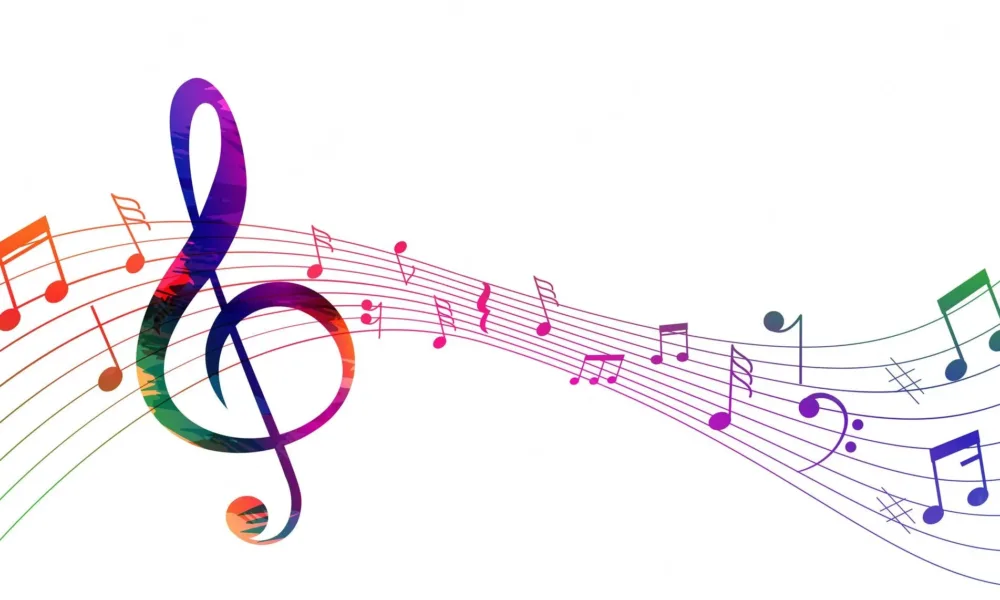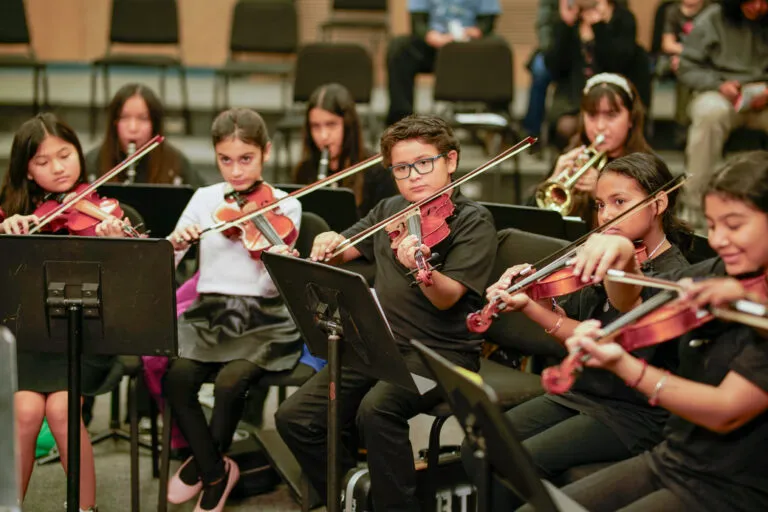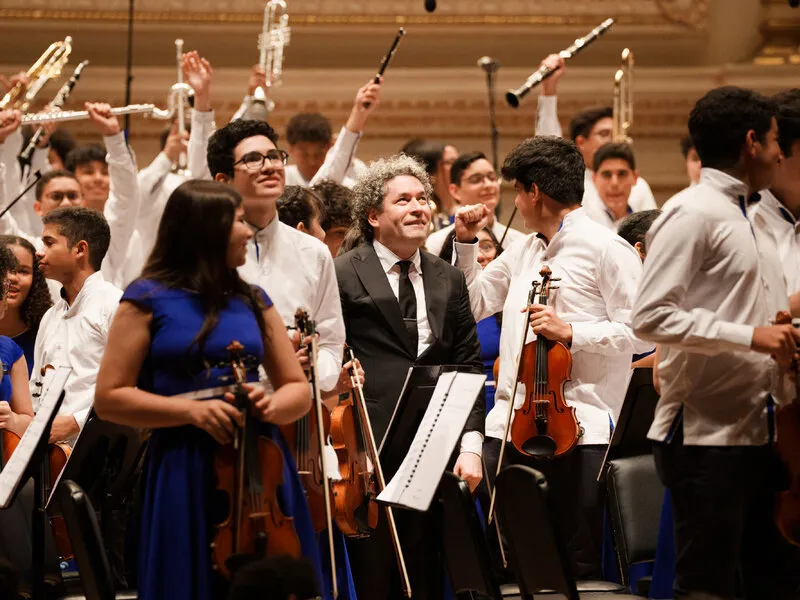In a small town scarred by conflict, where the sound of artillery once drowned out laughter, something extraordinary is happening. The hum of violins, the rhythmic pulse of drums, and the bright notes of flutes now echo through what used to be a deserted cultural hall. The performers? A group of teenagers — some barely old enough to drive — who have taken it upon themselves to replace the noise of war with the harmony of hope.
They call themselves The Harmony Youth Orchestra.
This orchestra, made up of local teens from different ethnic and religious backgrounds, is transforming a war-torn community into a place where music, rather than division, defines identity. Their story is not just about playing instruments; it’s about healing hearts, rebuilding trust, and proving that creativity can outshine conflict.
Table of contents
- The Birth of Harmony in Chaos
- The First Notes of Hope
- Building Bridges Through Music
- When Music Meets Healing
- A Symphony of Diversity
- The First Concert: A Night to Remember
- The Journey Beyond Borders
- Challenges Along the Way
- The Power of Purpose
- Voices of the Audience
- Music Education: A Path Forward
- The Science of Sound and Healing
- From War Zone to World Stage
- The Soundtrack of Resilience
- The Ripple Effect
- Lessons from the Harmony Youth Orchestra
- A Message to the World
- Epilogue: The Final Note
The Birth of Harmony in Chaos
The idea for the teen orchestra was born two years ago when Lina Haddad, a 17-year-old violinist, returned home after being displaced during the conflict. “I missed the sound of music more than anything,” she said. “When everything around you is broken, you start searching for one thing that still feels whole — for me, it was my violin.”
Lina’s teacher before the war, Maestro Karim, had stayed behind. He had lost his own son to the fighting and nearly gave up teaching altogether. But when Lina knocked on his door, violin in hand, asking for lessons again, something changed in him. Together, they decided to gather other young people — from both sides of the conflict — to create a space where music could mend what politics and violence had torn apart.
What began as a handful of students rehearsing in a basement soon grew into a 40-member youth orchestra representing every community in the region. They had no funding, limited instruments, and frequent power cuts. Yet, with determination and a dream, they played on.
The First Notes of Hope
The first rehearsal was awkward. Many of the teens had never met before, and some came from families still bitterly divided by the war. The tension was palpable.
“I remember the silence,” said Ahmed, a 16-year-old cellist. “Everyone looked at each other like we were strangers — or worse, enemies. But then Lina started to play. The room just changed.”
The melody she played was a traditional folk song known to both sides — a haunting yet beautiful tune that spoke of lost love and longing for peace. By the time she finished, a few of the teens had tears in their eyes. Someone clapped softly. Then, one by one, they joined in.
It was in that moment, they say, that the orchestra was truly born.
Building Bridges Through Music
The Harmony Youth Orchestra now performs in schools, hospitals, and refugee centers across the region. Each concert attracts crowds not for glamour but for the emotion that fills the air. Parents who once viewed one another with suspicion now sit side by side, watching their children play.

Music has a unique power to dissolve barriers — and in this community, it’s doing exactly that.
“The orchestra is not about forgetting what happened,” Maestro Karim explains. “It’s about remembering differently — remembering that we can choose harmony instead of hatred.”
To make rehearsals possible, families pooled resources, NGOs donated instruments, and even soldiers stationed nearby helped set up a rehearsal tent when the community hall was destroyed by shelling. Despite the constant challenges, the orchestra kept playing.
Every note became a declaration: We’re still here. We still believe.
When Music Meets Healing
Psychologists working with the group have observed that the teens who participate show remarkable emotional recovery. Music, it turns out, acts as therapy in places where words fall short.
Dr. Rasha Tamer, a trauma counselor who volunteers with the orchestra, says: “Many of these young musicians witnessed violence or lost loved ones. When they play, their bodies relax, their breathing slows, and their minds reconnect with something positive. Music gives them back their sense of control.”
Ahmed, the cellist, agrees. “When I play,” he says, “it feels like I can breathe again. The sound becomes bigger than the sadness.”
A Symphony of Diversity
One of the most striking aspects of the orchestra is its diversity. Christians, Muslims, Druze, and others — groups that rarely interacted during the years of fighting — now share the same stage. The musicians teach one another their traditional songs, blending rhythms and melodies that reflect their rich cultural mosaic.
Lina describes it best: “Our orchestra sounds different because we all bring our stories into the music. You can hear the pain, but you can also hear the hope.”
The orchestra’s repertoire includes a mix of Western classical pieces, local folk songs, and original compositions written by the teens themselves. Their signature piece, “Winds of Tomorrow,” begins with a mournful cello line and gradually builds into a triumphant chorus of violins and flutes — a sonic metaphor for their journey from despair to determination.
The First Concert: A Night to Remember
Their debut concert took place in the ruins of the town’s old theater. The roof had collapsed in places, and the seats were patched with wood and fabric. But for the community, it felt like the grandest hall in the world.
The concert began with a moment of silence for those lost in the conflict. Then, softly at first, the violins began to play.
For many in the audience, it was the first time in years they had heard live music. Some wept openly. Others simply closed their eyes and let the sound wash over them.
When the final note faded, the applause was thunderous — not just for the music, but for what it represented. In that applause was gratitude, relief, and the realization that healing had begun.
The Journey Beyond Borders
The Harmony Youth Orchestra’s story soon spread beyond their region. Videos of their performances went viral on social media, capturing the attention of musicians and humanitarian organizations around the world.

An international music foundation invited them to perform in a neighboring country, marking their first trip abroad. For most of the teens, it was their first time leaving home. They played in front of diplomats, journalists, and hundreds of other young people.
“When we performed outside our country, I realized we were ambassadors of peace,” Lina said. “People told us we gave them hope. That was the moment I understood how powerful our music could be.”
Since then, the orchestra has collaborated with European and Middle Eastern youth ensembles, performing online concerts and virtual exchanges to promote peacebuilding through art.
Challenges Along the Way
Despite their growing recognition, life for these young musicians remains challenging. Rehearsals are often interrupted by power outages, transportation is difficult, and some families still fear sending their children to mixed gatherings.
Funding is another major hurdle. The group relies on small donations, community fundraisers, and occasional grants to buy strings, repair instruments, and travel to performances.
But the teens have learned resilience. They repurpose old violins, share sheet music digitally, and rehearse by candlelight when necessary. Their determination has become a symbol of the region’s ability to rise from hardship.
The Power of Purpose
What drives these young musicians is more than passion for music — it’s a shared mission.
“We’re not just an orchestra,” says Lina. “We’re a family. Every time we play, we’re saying to the world: peace is possible.”
That purpose has rippled through their community. Parents have started community choirs; teachers use music in classrooms to ease anxiety among children; and local artists are painting murals inspired by the orchestra’s story.
As Maestro Karim puts it: “They came to learn music, but they ended up teaching all of us what courage sounds like.”
Voices of the Audience
At their most recent concert in a refugee camp, the reaction was overwhelming.
“My son hasn’t smiled in months,” one mother said after the show. “Today, I saw him laughing and clapping again. That means more than any medicine.”
An elderly man in the audience, who had lost his home, whispered: “When I heard that flute, I remembered the songs we used to sing before the war. For a moment, I was back there. It felt like time stopped.”
Moments like these remind the young performers why they keep going — not for fame or reward, but for connection.
Music Education: A Path Forward
Seeing the orchestra’s success, local authorities and NGOs are now exploring ways to introduce music education into schools again. For years, arts programs were seen as luxuries in the face of war. But the orchestra’s impact has proven that art is essential — especially in rebuilding societies.

Educational experts argue that creative programs like this foster emotional resilience, teamwork, and empathy — qualities critical for post-conflict recovery.
One teacher remarked, “Mathematics rebuilds infrastructure, but music rebuilds humanity.”
The Science of Sound and Healing
Research supports what these teens have discovered through experience: music can rewire the brain and reduce trauma symptoms. Studies show that playing an instrument or listening to rhythmic melodies releases dopamine and oxytocin — chemicals associated with happiness, bonding, and relaxation.
For children growing up in war zones, such activities can improve focus, reduce anxiety, and even strengthen memory.
Dr. Tamer believes these benefits extend beyond the individual: “When these teens play together, their brains synchronize. It’s literal harmony — a neurological connection that fosters empathy. That’s what societies recovering from violence desperately need.”
From War Zone to World Stage
Next year, the Harmony Youth Orchestra plans to tour Europe and the Middle East, performing at cultural festivals focused on peacebuilding. They are also collaborating with a documentary filmmaker to share their story globally.
The orchestra members know that fame is fleeting — but hope, if nurtured, can last.
Their ultimate goal is to build a permanent Music and Healing Center in their hometown — a space for workshops, therapy sessions, and community concerts. As Lina puts it: “We want a place where every child can pick up an instrument before they ever think of picking up a weapon.”
The Soundtrack of Resilience
Each performance by the teen orchestra carries the weight of stories untold — stories of loss, courage, and redemption. When they play, you can hear the echo of a generation refusing to be defined by war.
Their music has become the unofficial anthem of their community — a soundtrack of resilience.
Even amid ruins, their instruments sing of dawns yet to come.
The Ripple Effect
The orchestra’s journey has inspired other regions to start their own youth ensembles. Neighboring towns have launched “Peace Bands” and community choirs modeled after the Harmony Youth Orchestra.
Online, young musicians from across the world send messages of support, record virtual collaborations, and even donate instruments. What began as one small act of defiance has grown into an international movement celebrating the power of art to unite humanity.
Lessons from the Harmony Youth Orchestra
The orchestra’s success offers timeless lessons for communities everywhere:

- Healing begins with connection. Music creates shared experiences that transcend language and politics.
- Youth can lead peacebuilding. Empowering teenagers to take initiative transforms victims into changemakers.
- Creativity is resilience. Art isn’t a distraction from hardship — it’s a way through it.
- Small efforts multiply. One violin lesson sparked a global message of unity.
- Peace is a practice. Like music, it takes daily effort, listening, and patience.
A Message to the World
The Harmony Youth Orchestra’s story reminds us that even in the darkest times, humanity finds a way to sing again. Their courage is proof that compassion can be louder than hatred, and that no border, ideology, or wound is too deep for the sound of a song.
They are not just teens with instruments. They are storytellers, healers, and architects of a better tomorrow.
In their music, the world hears a promise — that beauty can return, even after everything else has been taken away.
Epilogue: The Final Note
During their last concert of the year, under a sky lit with paper lanterns, the orchestra performed “Winds of Tomorrow.” As the final chord echoed into the night, Lina looked out at the crowd — families, soldiers, aid workers, and children — all standing together, united in silence.
Tears welled in her eyes. For the first time in years, she felt not fear, but peace.
The applause that followed wasn’t just for the music. It was for hope reborn, for courage rediscovered, for harmony regained.
And as the young musicians packed up their instruments, they knew that tomorrow, somewhere in that war-torn land, a new sound had taken root — not the echo of gunfire, but the song of a generation choosing peace.
